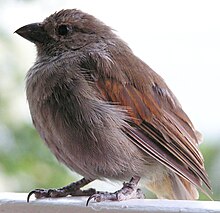Loxigilla
| Loxigilla | |
|---|---|

| |
| Barbados bullfinch (Loxigilla barbadensis) | |
| Scientific classification | |
| Domain: | Eukaryota |
| Kingdom: | Animalia |
| Phylum: | Chordata |
| Class: | Aves |
| Order: | Passeriformes |
| Family: | Thraupidae |
| Genus: | Loxigilla Lesson, 1831 |
| Type species | |
| Fringilla noctis Linnaeus, 1758
| |
| Species | |
|
See text | |
| Synonyms | |
|
Pyrrhulagra | |
Loxigilla is a genus of passerine birds in the tanager family Thraupidae. The two species are both endemic to the Lesser Antilles.
Taxonomy
[edit]The genus Loxigilla was introduced in 1831 by the French naturalist René Lesson.[1] The type species was later designated as the Lesser Antillean bullfinch by George Robert Gray in 1855.[2][3] The name is a combination of two genera introduced by Carl Linnaeus in 1758: Loxia for the crossbills and Fringilla for a group of finches.[4] Although formerly placed with the buntings and New World sparrows in the family Emberizidae,[3] molecular phylogenetic studies have shown that the genus is a member of the tanager family Thraupidae and belongs to the subfamily Coerebinae which also includes Darwin's finches.[5]
The genus contains two species, both endemic to the Lesser Antilles:[6]
| Image | Common Name | Scientific name | Distribution |
|---|---|---|---|
 |
Lesser Antillean bullfinch | Loxigilla noctis | Saint Barth, Saint Martin, Anguilla, Antigua and Barbuda, Dominica, Grenada, Guadeloupe, Martinique, Montserrat, Netherlands Antilles, Saint Kitts and Nevis, Saint Lucia, Saint Vincent and the Grenadines, the British Virgin Islands, and the U.S. Virgin Islands. |
 |
Barbados bullfinch | Loxigilla barbadensis | Barbados |
The Greater Antillean bullfinch and Puerto Rican bullfinch were formerly placed in this genus, but are now placed in Melopyrrha.[6][5][7]
References
[edit]- ^ Lesson, René (1831). Traité d'Ornithologie, ou Tableau Méthodique (in French). Vol. 1. Paris: F.G. Levrault. p. 443.
- ^ Gray, George Robert (1855). Catalogue of the Genera and Subgenera of Birds Contained in the British Museum. London: British Museum. p. 74.
- ^ a b Paynter, Raymond A. Jr, ed. (1970). Check-List of Birds of the World. Vol. 13. Cambridge, Massachusetts: Museum of Comparative Zoology. p. 157.
- ^ Jobling, James A. (2010). The Helm Dictionary of Scientific Bird Names. London: Christopher Helm. p. 231. ISBN 978-1-4081-2501-4.
- ^ a b Burns, K.J.; Shultz, A.J.; Title, P.O.; Mason, N.A.; Barker, F.K.; Klicka, J.; Lanyon, S.M.; Lovette, I.J. (2014). "Phylogenetics and diversification of tanagers (Passeriformes: Thraupidae), the largest radiation of Neotropical songbirds". Molecular Phylogenetics and Evolution. 75: 41–77. Bibcode:2014MolPE..75...41B. doi:10.1016/j.ympev.2014.02.006. PMID 24583021.
- ^ a b Gill, Frank; Donsker, David; Rasmussen, Pamela, eds. (July 2020). "Tanagers and allies". IOC World Bird List Version 10.2. International Ornithologists' Union. Retrieved 14 November 2020.
- ^ Burns, K.J.; Unitt, P.; Mason, N.A. (2016). "A genus-level classification of the family Thraupidae (Class Aves: Order Passeriformes)". Zootaxa. 4088 (3): 329–354. doi:10.11646/zootaxa.4088.3.2. PMID 27394344.
